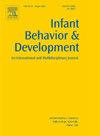婴儿在游戏中的拉站行为组织:纵向调查
IF 1.9
3区 心理学
Q3 PSYCHOLOGY, DEVELOPMENTAL
引用次数: 0
摘要
拉立(PTS)是一种重要的过渡姿势,可以促进向步行的转变,但婴儿在学会走路后仍然经常发生PTS。我们选取了一组13名三周前学习过PTS的婴儿,目的是追踪PTS、站立和行走经验的提高如何促进婴儿选择更熟练的PTS策略,并重组婴儿如何使用PTS促进自由玩耍。我们在10个两周一次的实验室会议中跟踪了自发性PTS,并对PTS技能进行了视频编码功能测量,包括手、膝盖和脚的使用(例如,侧面、手和脚的步骤),以及婴儿在游戏中如何使用PTS,包括PTS后立即的行为。结果显示,婴儿在进行PTS时经常采用熟练的半跪策略,尽管这种策略比对称PTS策略慢。大多数PTS涉及手和腿的不对称和对角激活,提供稳定的重心,侧向脚的偏好强而稳定。PTS技能的其他功能测量显示,随着时间的推移,婴儿PTS使用较少的交替手步,效率提高。最初,婴儿使用固定的物体进行PTS,然后与物体和母亲进行互动,但随着时间的推移,婴儿越来越多地使用楼梯和楼梯栏杆进行PTS,并在PTS后进行更多的运动探索。即使在最初发病的几个月后,婴儿继续完善PTS策略和效率,并在游戏中以不同的方式使用PTS进行物体交互和运动探索,这突出了PTS期间肢体间协调和目标导向行为跟踪模式的重要性。本文章由计算机程序翻译,如有差异,请以英文原文为准。
Infants’ organization of pull-to-stand behaviors during play: A longitudinal investigation
Pulling-to-stand (PTS) is an important transitional posture which may facilitate the shift to walking, but infants still frequently PTS even after learning to walk. Using a group of 13 infants who had learned to PTS about three weeks prior, we aimed to track how gains in PTS, standing, and walking experience contributed to infants’ selection of more skilled PTS strategies and reorganized how infants used PTS to facilitate free play. We tracked spontaneous PTS over 10 biweekly laboratory sessions and video-coded functional measures of PTS skill, including hand-, knee-, and foot-use (e.g., lateral sides, hand- and foot-steps), and how infants used PTS during play, including behaviors immediately following PTS. Results showed infants frequently adopted skilled half-kneel strategies en route to PTS even though they were slower than symmetric PTS strategies. Most PTS involved asymmetrical and diagonal activation of the hands and legs, offering a stable center of gravity, and lateralized foot preferences were strong and stable. Other functional measures of PTS skill revealed increased efficiency over time, as infants PTS using fewer alternating hand-steps. Initially, infants PTS using stationary objects and then interacted with objects and mothers, but over time, infants increasingly PTS using the stairs and stair rails and engaged in more locomotor exploration following PTS. Even months after its initial onset, infants continued to refine PTS strategies and efficiency and used PTS differently for object interactions and locomotor exploration during play, which highlights the importance of tracking patterns of interlimb coordination during PTS and goal-directed behavior in context.
求助全文
通过发布文献求助,成功后即可免费获取论文全文。
去求助
来源期刊

Infant Behavior & Development
PSYCHOLOGY, DEVELOPMENTAL-
CiteScore
4.10
自引率
4.80%
发文量
94
期刊介绍:
Infant Behavior & Development publishes empirical (fundamental and clinical), theoretical, methodological and review papers. Brief reports dealing with behavioral development during infancy (up to 3 years) will also be considered. Papers of an inter- and multidisciplinary nature, for example neuroscience, non-linear dynamics and modelling approaches, are particularly encouraged. Areas covered by the journal include cognitive development, emotional development, perception, perception-action coupling, motor development and socialisation.
 求助内容:
求助内容: 应助结果提醒方式:
应助结果提醒方式:


